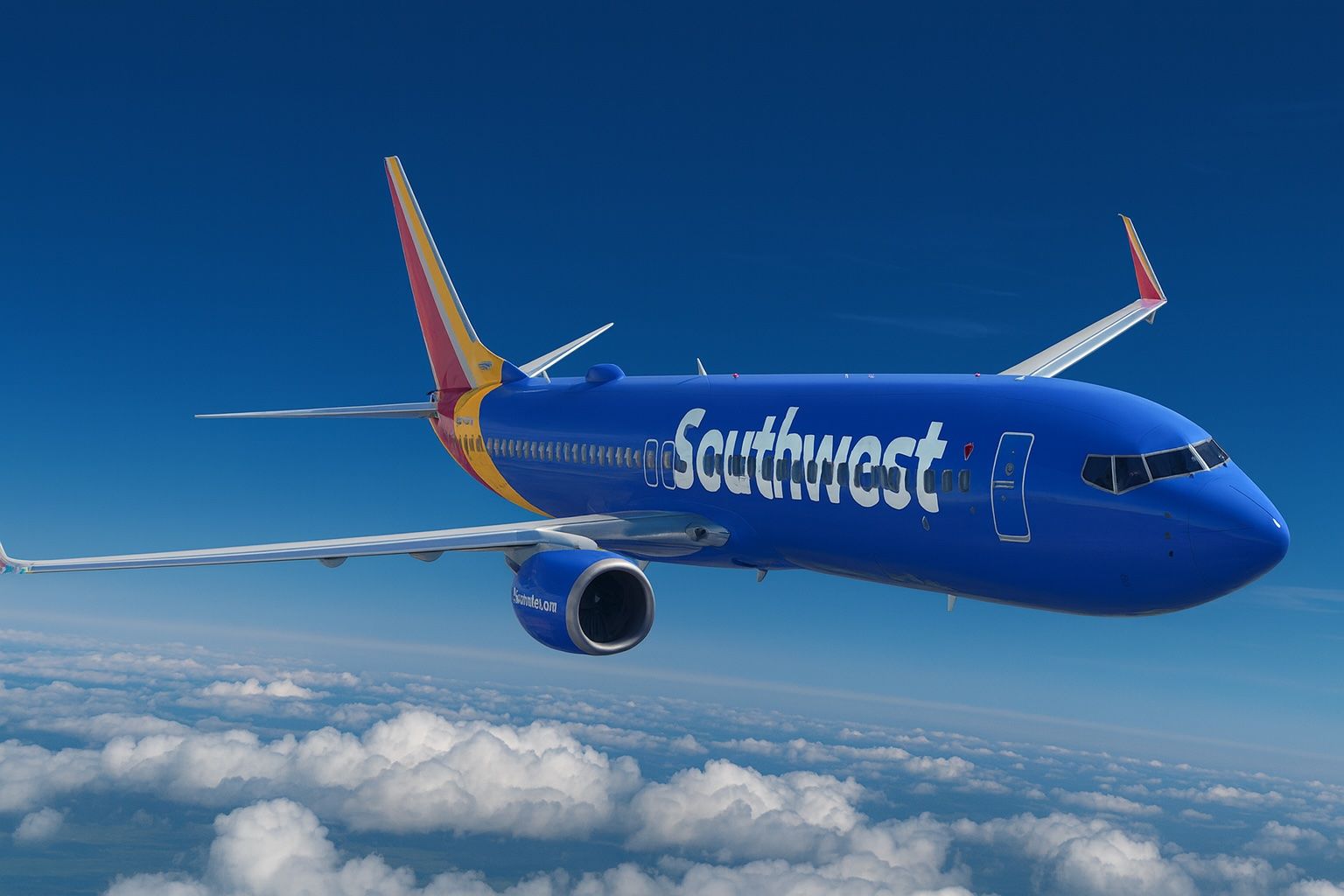- Stock Surge: Southwest Airlines Co. (NYSE: LUV) jumped nearly 5% on October 14, closing around $33.50 [1]. The rally puts LUV at its highest level in weeks, though shares remain about 12% below their 52-week high (~$38 in July) [2]. Year-to-date, the stock was down ~4% before today’s spike [3].
- Analyst Upgrades: Wall Street is turning cautiously optimistic. Susquehanna raised its price target to $35 (from $30) ahead of Q3 earnings, maintaining a Neutral rating [4] [5]. TD Cowen likewise boosted its target (to $24 from $21, Hold rating), citing “improving demand trends” and “strong close-in holiday leisure bookings” that could lift Q4 results [6] [7]. Susquehanna analysts added that Southwest’s recently authorized $2 billion stock buyback signals confidence in the airline’s long-term value [8].
- Q3 Earnings on Deck: Southwest reports Q3 results later this month (Oct. 23). Analysts widely expect a sharp drop in profitability versus a year ago [9]. Higher costs and softer summer demand have led the carrier to slash its full-year profit forecast. In fact, Southwest cut its 2025 EBIT outlook to $600–$800 million (from a prior $1.7 billion) after a weak Q2 [10] [11]. The upcoming report will be closely watched for holiday booking trends and any revised guidance.
- Industry Trends: Travel demand is recovering unevenly. Premium international routes are booming – Delta and United just posted strong Q3 results on affluent travelers splurging for upgrades. But as the largest domestic-focused airline, Southwest faces price-sensitive U.S. leisure demand that has lagged. The company noted summer leisure bookings were “depressed” and it had to discount fares [12], causing Q2 revenue per seat to fall ~3% [13]. While Southwest says demand “shows signs of improvement” heading into year-end [14], one analysis noted the carrier’s holiday strength “is still an unknown” compared to its legacy competitors [15].
- Exec & Expert Commentary: CEO Bob Jordan has emphasized Southwest’s long-term strategy despite near-term headwinds. The airline is implementing “transformational changes” – in Q2 it even began charging for checked bags (ending a decades-long free-bag perk) and rolled out a new basic economy fare tier [16]. Those moves aim to boost revenue, though initial rollout hit some snags (bag fee revenue beat expectations, but the new fare launch hurt Q2 sales [17]). Southwest’s management remains upbeat that travel demand will rebound: “Recent industry demand shows signs of improvement off…depressed [summer] levels,” the company said in July [18]. Market experts also point to external positives: jet fuel prices have eased (~13% lower YoY) [19] [20], which should help airlines’ margins reach ~3.7% profit this year [21].
- Broader Factors: Government and regulatory conditions are a mixed bag. A looming U.S. government shutdown (which began Oct. 1) has not grounded air travel yet – TSA security and FAA traffic control are deemed essential – but thousands of flight delays have been occurring as staffing gets stretched [22]. So far airline stocks (including LUV) have largely shrugged it off [23], on hopes any shutdown will be short. However, a protracted federal impasse could undermine consumer confidence and holiday bookings, analysts warn [24]. On the labor front, Southwest’s pilots secured a new five-year contract with ~50% in pay raises over 2024–2028 [25] [26], and flight attendants recently rejected a proposed deal seeking similarly rich terms [27]. While these labor wins improve morale, they also raise Southwest’s cost base in coming years – another factor in analysts’ tempered outlooks.
Recent Stock Performance: Volatile Climb into Mid-October
Southwest’s stock has seen choppy trading in recent weeks, but momentum improved dramatically heading into mid-October. The shares have rallied from the low-$30s to mid-$33 range in just the past few sessions [28]. On October 14, LUV spiked nearly 5% intraday – a significant one-day move – amid a broader market surge. It closed around $33.47 [29], up from $31.90 the prior close [30].
This jump puts Southwest back in positive territory for Q4-to-date and close to breakeven on the year. Before today’s move, LUV was down roughly 3.9% year-to-date [31], underperforming the S&P 500. The stock remains well below its summertime peak: in July, Southwest traded above $37 (its 52-week high) before a late-summer swoon [32]. At ~$33, shares are still about 12% shy of that high-water mark, reflecting the operational and profit challenges that emerged over the summer.
Notably, trading volume on the recent rally has been above average, indicating strong investor interest. On one of this week’s “up” days, volume hit ~11.5 million shares, eclipsing the 9.9M 50-day average [33]. Some of this buying may be short-covering (Southwest had a relatively high short interest earlier in the month [34]). It also suggests fresh optimism as traders position ahead of the Q3 earnings release.
Technical perspective: Even after the pop, LUV’s chart shows it bouncing off recent support in the low $30s. Analysts note key levels around $30 as support and ~$35 as near-term resistance. A decisive break above the mid-$30s would be psychologically positive, potentially opening a path back to the high-$30s if earnings or holiday demand surprises to the upside. Conversely, any disappointment in the upcoming report could send shares retesting the $30 floor.
Analyst Commentary: Mixed Ratings, Brighter Spots Ahead?
Wall Street’s view on Southwest is lukewarm but improving at the margins. The consensus analyst rating sits around a “Hold” (mean ~3.0 on a 1–5 scale) [35]. Out of 22 analysts tracked, only 5 rate LUV a “Buy”, while 11 say “Hold” and 6 recommend “Sell” [36] – reflecting the tough year Southwest has had operationally. The median 12-month price target is about $34 [37], essentially where the stock trades now, implying modest upside. In short, the average analyst isn’t pounding the table on LUV at the moment.
However, there are bullish glimmers. In early October, multiple firms raised their targets and offered cautiously positive notes. Susquehanna Financial, for example, hiked its target to $35 (from $30) ahead of earnings [38]. While maintaining a neutral stance, Susquehanna’s analysts cited encouraging signs like Southwest’s $2 billion share buyback plan, which they interpret as a sign of management’s confidence in the company’s value and strategy [39]. A $35 target suggests roughly 8% upside from recent prices – not dramatic, but an improvement from earlier skepticism.
Likewise, TD Cowen analysts raised their target and highlighted Southwest’s recent resilience. “LUV demonstrated resilient operations in Q3, navigating challenges such as July weather disruptions and the Dallas ATC outage,” the TD Cowen team noted [40]. They pointed to an improved demand outlook: booking trends for the upcoming Thanksgiving and Christmas travel season appear strong, with “strong close-in holiday leisure bookings expected to provide upside in Q4” [41]. In plain terms, people are booking holiday flights later than usual, and those last-minute higher-fare tickets could boost Southwest’s revenues in the fourth quarter.
Another focus for analysts is cost control and margin recovery. Here, opinions vary. Some worry that Southwest’s cost per available seat mile (CASM) is rising too quickly – management guided Q3 non-fuel CASM up 4%–5.5% YoY [42] [43], partly due to pay raises and investments in operational reliability. These higher costs, combined with flat unit revenues, threaten near-term margins. On the other hand, fuel prices have been a surprise tailwind: jet fuel in 2025 has been cheaper than last year (averaging ~$86/barrel, ~13% lower YoY) [44] [45]. This has given airlines some breathing room to absorb other expenses, and Southwest’s extensive fuel hedging program may provide extra cushion. Market experts at S&P Global project that lower oil prices will help push industry-wide airline profit margins to about 3.7% in 2025 [46], a noticeable improvement.
Overall, short-term forecasts for LUV remain cautious. Many analysts have cut 2025 earnings estimates for Southwest after its summer guidance reset. The current consensus expects only around $1.00 in EPS for full-year 2025 [47] (down sharply from earlier forecasts), which at ~$33/share gives a forward P/E near 32 [48] – a rich valuation unless growth resumes. This explains the preponderance of Hold/Sell ratings. Bulls argue these estimates are too low if demand snaps back. They point out that Southwest has beaten earnings expectations by an average of 59% in recent quarters [49] (often due to one-time factors), so any positive surprise in Q3 or upbeat holiday outlook could spur a re-rating of the stock.
Company Outlook: Holiday Hopes and New Initiatives
Southwest’s management acknowledges 2025 has been challenging, but they assert the airline is positioned for a rebound as consumers adjust and travel patterns normalize. In the second quarter, Southwest saw a notable slump in leisure bookings during late spring, which they attributed to “lingering uncertainty about the broader economy… and rising living costs” for U.S. consumers [50] [51]. Essentially, many price-sensitive travelers skipped or delayed trips, forcing Southwest to discount fares to fill planes. This hurt revenues – Q2 passenger revenue fell and load factors slipped – and led the airline to dramatically cut its profit forecast for the year [52] [53].
To reignite growth, Southwest has rolled out several strategic changes:
- Fare and Fee Changes: Famously a holdout in the industry, Southwest ended its “Bags Fly Free” policy in mid-2025, which had long allowed two free checked bags per passenger. The airline began charging bag fees like competitors, and reported that bag fee revenue exceeded expectations in its initial months [54] [55]. Additionally, Southwest introduced a new Basic Economy fare class (with fewer perks) to better segment price-sensitive customers. However, the Basic Economy launch saw some hiccups – sales on Southwest’s website were initially lower than expected in May, which management admitted hurt Q2 unit revenue [56]. The company says it has tweaked marketing of the new fares and expects better traction going forward.
- Operational Investments: After a high-profile systems meltdown in late 2022, Southwest has been investing heavily in IT upgrades, scheduling tools, and staffing. Those efforts paid off in smoother operations this year – even when faced with major disruptions like severe July storms and an FAA air-traffic control outage in Dallas, Southwest managed to limit cancellations and recover quickly [57]. Executives noted the airline’s “resilient operations” in navigating these challenges [58]. Reliable operations are crucial for Southwest’s lucrative holiday season: the airline has added extra buffers to its schedule to avoid cascading delays, and it touts improvements in on-time performance heading into winter.
- Network Expansion: Contrary to some rivals who trimmed capacity, Southwest is modestly expanding its route map. The carrier is opening new international routes (for example, to Turks and Caicos this winter) and boosting domestic service in growth markets. Just this week, Southwest announced it will launch two new routes from Austin Bergstrom in June 2026 [59], tapping into surging Texas travel demand. In a first, Southwest also plans to start service to Anchorage, Alaska – its debut in the far north – by early 2026 [60]. This will extend Southwest’s reach to all 50 states and indicates confidence in leisure travel demand. Additionally, the airline has extended its booking schedule through late 2025, adding flights in business hubs and popular vacation destinations [61] [62] (Southwest scheduled a record 128 daily flights from Austin this month, showcasing its growth there [63]).
- Shareholder Returns: Despite leaner profits, Southwest’s board approved a $2 billion share repurchase program (about 12% of its market cap) to opportunistically buy back stock. Susquehanna analysts interpreted this as a strong vote of confidence in the company’s long-term strategy [64]. While some investors would prefer cash be conserved until earnings recover, Southwest has a fortress balance sheet by industry standards (it’s one of the few U.S. airlines with an investment-grade credit rating and relatively low debt [65] [66]). The company appears comfortable that it can reward shareholders and fund operations, which bodes well if demand accelerates.
Looking ahead to the crucial holiday season, Southwest is optimistic. Thanksgiving and Christmas travel are typically peak profit periods for domestic airlines, and indications are that Americans still plan to fly in record numbers. The wrinkle is booking patterns: industry data show many travelers have been booking later than usual this year, perhaps waiting for deals or clarity on finances [67]. This makes it harder for airlines to forecast. Southwest executives have hinted that early October booking trends were encouraging, but the airline stopped short of issuing a formal revenue upgrade. We will learn more on the Q3 earnings call, where Southwest will likely give an updated Q4 outlook. Given the importance of Q4, any commentary on December demand or early 2026 bookings could move the stock.
Broader Airline Industry Context: Headwinds and Tailwinds
Southwest’s fortunes are tied to the broader airline industry cycle, which in late 2025 is sending mixed signals:
- Travel Demand: Overall U.S. air travel demand remains resilient post-pandemic, especially for leisure trips. TSA checkpoint volumes have been consistently nearing or exceeding 2019 levels on many days. International travel is a bright spot – Americans are splurging on overseas trips, and foreign tourists are returning. However, domestic leisure demand (Southwest’s bread and butter) saw a soft patch in mid-2025 as noted. Higher interest rates and inflation squeezed the budgets of middle-class travelers, leading to what Southwest called “tepid demand from U.S. consumers” in Q2 [68]. The good news: by late summer, airlines reported a rebound. United and Alaska Airlines each noted booking pickups heading into autumn [69] [70]. Southwest, being the most domestic-focused major carrier, will be an important bellwether for whether U.S. vacationers are fully back in force this holiday season.
- Fare Trends: A key challenge in 2025 has been weak pricing power for economy fares. With airlines adding back capacity and discount carriers aggressively vying for market share, domestic ticket prices dropped. Southwest acknowledged it had to cut fares to stimulate demand in early 2025 [71] [72]. At the same time, premium cabin fares (first/business class, which Southwest doesn’t offer) have held up or risen – benefiting network airlines like Delta, United. This divergence hurts Southwest’s unit revenues. Industry-wide, revenue per available seat mile (RASM) declined for many carriers in Q3. The trend may improve if competitors cut expansion plans or if jet fuel costs stay low, allowing for fare stability. Notably, several airlines (United, American) have recently signaled they will trim 2024 capacity growth to firm up pricing. Southwest itself kept capacity flat in Q3 vs. 2024 [73], and is focusing on yield over volume for now. If fare discounting abates, Southwest could see its revenue metrics improve next year.
- Cost Pressures:Labor and fuel are the two biggest expenses for airlines, and both have seen dynamic changes. On fuel, as discussed, the trend has been positive – oil prices have been lower than last year’s highs, and Southwest also enjoys a sizable fuel hedge book (which mitigates price spikes). On labor, though, costs are rising industry-wide. Southwest’s pilots won a 29% immediate pay raise (plus 4% annual raises in 2025–27) in their new contract [74]. Delta, United, American also signed rich pilot deals, ratcheting up the cost structure. Furthermore, other work groups are demanding similar raises; in Southwest’s case, its flight attendants union voted 93% to authorize a strike earlier in 2025 and rejected a contract that would have made them the highest-paid in the industry [75]. Those negotiations continue. Such labor disputes haven’t disrupted operations (Southwest says there’s “no impact on scheduled flights” from the strike vote [76]), but investors are wary that new labor contracts will pressure profit margins for years to come. On the flip side, from a customer service standpoint, a happy workforce could improve reliability and customer satisfaction – areas that matter for Southwest’s brand after past stumbles.
- Regulatory/Government Factors: The U.S. government’s role looms in several ways. First, the partial government shutdown that began on Oct. 1 has so far not derailed air travel – air traffic controllers and TSA agents are working without pay, keeping planes moving [77]. But if Washington’s budget impasse drags on, staffing shortages could worsen (already by Oct. 7 there were 3,000+ daily flight delays attributed to fewer available controllers) [78]. Airlines are lobbying hard for a resolution, knowing a prolonged shutdown might scare off travelers or snarl the vital Thanksgiving travel week. Another factor is the FAA’s modernization efforts: regulators are implementing new air-traffic systems and 5G safety rules that at times cause temporary flight restrictions. Southwest, with many flights in busy U.S. corridors, is affected by any ATC delays or safety directives, though these are usually short-term issues. Lastly, Congress has been debating passenger rights (like compensation for delays) and industry competition. Any new rules could impact Southwest’s costs or how it handles irregular operations. Thus far, no major regulatory changes have passed in 2025, but it’s an area to watch.
In summary, Southwest is navigating an environment with crosswinds – strong travel demand but skewed towards segments it doesn’t serve; lower fuel costs but higher labor expenses; and a solid balance sheet but thinner profits. These broader trends frame the expectations for Southwest’s stock going forward.
Forecast and Outlook: Cautious Optimism into 2026
Going into the final months of 2025, market sentiment on LUV stock is improving slightly from the pessimism of mid-year. The holiday season could be a pivotal turning point. If Southwest can report decent Q3 results (or at least meet the lowered expectations) and issue an upbeat commentary on holiday bookings, it may restore investor confidence that the carrier’s earnings will climb in 2024.
Short-term, expect the stock to be sensitive to Q3 earnings (Oct. 23) and any guidance. Analysts are bracing for weak Q3 numbers – some even project an outright loss for the quarter [79] – given that Q3 2024 was profitable. Thus, the bar is low. The key will be management’s tone on Q4: Are bookings accelerating enough to return Southwest to year-over-year profit growth by Q4 or Q1? Any positive surprise in unit revenue or an extension of the buyback could spur a relief rally. Conversely, if Southwest disappoints again or guides cautiously, the stock’s recent gains might evaporate as investors fear a longer recovery timeline.
Over the medium term (6–12 months), many analysts see limited upside unless demand momentum builds. The average price target in the mid-$30s suggests only a small gain ahead [80]. However, there are scenarios where Southwest could outperform: for instance, a robust rebound in domestic flying (perhaps as U.S. consumers adjust to inflation or if the economy strengthens) would directly boost Southwest’s bottom line. Also, Southwest has levers to pull – its new revenue initiatives (bag fees, fare tiers) could contribute hundreds of millions in extra annual revenue once fully ramped. If combined with stabilizing fuel prices and disciplined cost management, Southwest’s earnings could surprise to the upside in 2024. In that case, some on Wall Street argue LUV’s valuation would look attractive for a company known to deliver stable profits pre-pandemic.
It’s worth noting that Southwest entered 2025 as a bit of a value stock story: it had a low price-to-sales ratio (~0.6) [81] and a solid balance sheet, but depressed earnings. Zacks Equity Research recently highlighted LUV as a “Strong Value” pick, giving it an “A” grade for value based on metrics and noting its strong cash flows and improvements in earnings estimates [82]. They rate Southwest a Zacks #3 Hold currently, but with top-tier value and growth scores, suggesting the stock has upside if operational performance improves [83]. This underscores that investor perception could shift quickly – from value trap to value opportunity – if Southwest can demonstrate that the worst of 2025’s turbulence is behind it.
In the near term, volatility is likely to remain. Airline stocks often swing with headlines on oil prices, geopolitics, or health scares. Southwest’s relative stability and famous low-cost model have long made it a favorite for long-term holders, and it still pays a dividend (current yield ~2.3% [84]) which it reinstated after the pandemic. For now, prudent investors seem to be in “wait and see” mode until the carrier proves it can navigate the current air pockets. But with holiday travel demand appearing solid and analysts like Susquehanna and TD Cowen starting to warm up to LUV, there’s a sense that Southwest’s stock could finally be ready for takeoff – if the company delivers in the coming quarters.
Sources: Official company statements, Southwest’s Q2 2025 earnings report [85] [86], analyst reports (Susquehanna, TD Cowen) via Reuters [87] [88] and Yahoo Finance, TS² and Reuters market analysis [89] [90], and industry data from IATA/S&P Global [91]. All information is up to date as of October 14, 2025.
References
1. www.reuters.com, 2. www.itiger.com, 3. www.tradingview.com, 4. swingtradebot.com, 5. www.tradingview.com, 6. www.tradingview.com, 7. www.tradingview.com, 8. www.tradingview.com, 9. swingtradebot.com, 10. www.reuters.com, 11. www.reuters.com, 12. www.reuters.com, 13. www.reuters.com, 14. www.reuters.com, 15. ts2.tech, 16. www.reuters.com, 17. www.reuters.com, 18. www.reuters.com, 19. www.iata.org, 20. www.spglobal.com, 21. www.spglobal.com, 22. ts2.tech, 23. ts2.tech, 24. ts2.tech, 25. www.reuters.com, 26. www.reuters.com, 27. www.reuters.com, 28. www.reuters.com, 29. www.reuters.com, 30. www.reuters.com, 31. www.tradingview.com, 32. www.itiger.com, 33. www.itiger.com, 34. intellectia.ai, 35. www.reuters.com, 36. www.tradingview.com, 37. www.tradingview.com, 38. swingtradebot.com, 39. www.tradingview.com, 40. www.tradingview.com, 41. www.tradingview.com, 42. www.reuters.com, 43. www.reuters.com, 44. www.iata.org, 45. www.spglobal.com, 46. www.spglobal.com, 47. www.nasdaq.com, 48. www.nasdaq.com, 49. www.nasdaq.com, 50. www.reuters.com, 51. www.reuters.com, 52. www.reuters.com, 53. www.reuters.com, 54. www.reuters.com, 55. www.reuters.com, 56. www.reuters.com, 57. www.tradingview.com, 58. www.tradingview.com, 59. www.intratio.com, 60. www.intratio.com, 61. www.swamedia.com, 62. www.swamedia.com, 63. www.swamedia.com, 64. www.tradingview.com, 65. www.reuters.com, 66. www.reuters.com, 67. www.tradingview.com, 68. www.reuters.com, 69. www.reuters.com, 70. www.reuters.com, 71. www.reuters.com, 72. www.reuters.com, 73. www.reuters.com, 74. www.reuters.com, 75. www.reuters.com, 76. www.swamedia.com, 77. ts2.tech, 78. ts2.tech, 79. www.ainvest.com, 80. www.tradingview.com, 81. www.reuters.com, 82. www.nasdaq.com, 83. www.nasdaq.com, 84. www.reuters.com, 85. www.reuters.com, 86. www.reuters.com, 87. www.tradingview.com, 88. www.tradingview.com, 89. ts2.tech, 90. ts2.tech, 91. www.spglobal.com







